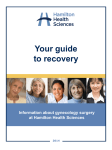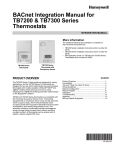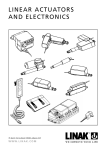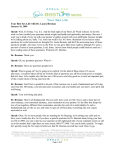Download Having an abdominal hysterectomy – an operation to remove your
Transcript
Having an abdominal hysterectomy – an operation to remove your womb This booklet aims to help you prepare for your hysterectomy and your recovery afterwards. It will give you general information about your operation as well as a list of useful contacts. It is not unusual for people to feel anxious about having an operation. If you have any questions or concerns, please do not hesitate to talk to the doctors and nurses caring for you. You can find their contact details on page 12. The medical words used in this booklet are printed in bold type and there is a glossary on page 16 to explain words you might not know. Contents page What is a hysterectomy? 2 Preparing for your operation 4 During the operation 4 After the operation 6 Going home 7 When to contact your doctor 9 Common questions 9 Further information – contact details 12 Checklist (for before and after your operation) 14 Glossary 15 1 of 17 What is an abdominal hysterectomy? An abdominal hysterectomy is an operation to remove your womb (uterus) by making an incision (cut) in your abdomen (tummy). A general anaesthetic is used, which is medication that causes you to sleep during the entire operation. Where is my womb (uterus)? Your womb is normally about the size of a pear, but varies in size between women. It sits between the bladder and the rectum (back passage) at the top of the vagina – please see figures 1 and 2. lymph nodes ovary fallopian tube womb (uterus) vagina Fig. 1 Fig. 2 2 of 17 What are the benefits of having an abdominal hysterectomy? There are many different reasons for having a hysterectomy. It can be done to treat problems including: • heavy/painful periods, especially if other treatments have failed • growths in your womb such as fibroids or recurrent polyps • cancer, although this is less common. These are just a few of the reasons why you might have a hysterectomy. Your doctor will speak to you about why this operation may be suitable for you. Are there alternatives to having an abdominal hysterectomy? Yes, there are other treatments that can sometimes be used such as medicines or endometrial ablation to treat the lining of your womb. A hysterectomy can also be performed vaginally or laparoscopically. A vaginal hysterectomy is where the surgery is performed through your vagina (avoiding the need to cut your abdomen). A laparoscopic hysterectomy is where several small cuts are made to your abdomen, rather than one large one. The options available to you will depend on why the surgery is being recommended and your individual circumstances. Your doctor will discuss this with you in more detail. What risks are involved with an abdominal hysterectomy? There are risks associated with any surgical procedure. Your surgeon will explain these risks to you before you sign the consent form. This form confirms that you agree to have the operation and understand what it involves. Please ask questions if you are uncertain. You should have received the leaflet, Helping you decide: our consent policy, which gives you more information. If you have not, please ask us for one, Alternatively, you can contact the Knowledge & Information Centre (contact details at the end of this leaflet). Possible risks and complications from this surgery are: • bleeding during or after your operation – this may need to be treated with a blood transfusion • infections – you might be given antibiotics to help prevent this • blood clots – please refer to the leaflet Preventing hospital-acquired blood clots. • a cut in your bowel or bladder – this would be repaired during the operation • making a slow recovery • problems caused by having a general anaesthetic – minor risks include feeling nauseous (sick) afterwards, but it is also possible to have an allergic reaction to anaesthetic. This is rare, but you should tell your doctor about any allergies you have well in advance of your operation. These complications are usually rare but you must be aware of them. As with any operation, there is a risk of death, although this is also rare. Please talk to your doctor about any concerns you have before your operation. 3 of 17 Which type of hysterectomy will I be having? There are different types of hysterectomy for treating different gynaecological problems. Your doctor will explain: • which type of hysterectomy you are having and why • how the surgery is carried out; and • what is being removed during your hysterectomy. Preparing for your operation Please see the checklist on page 14 for details on what to bring with you. What happens before my operation? We will ask you to come to the hospital for a pre-admission appointment, during which we will carry out some tests and talk to you about your operation and the Enhanced Recovery Program (ERP). You will be given a leaflet which explains the ERP programme in full. You will also be given some special pre-operative drinks to help your body be better prepared for surgery. The drinks and an information leaflet about the drinks will be available to take home with you. You will also be given some Chlorhexidine (antiseptic) wipes to take away with you. You will need to use these before your operation to clean the skin and help prevent any infection. You will be given full instructions on how and when to use these by the pre-assessment team. You will normally be admitted to the Surgical Admissions Lounge (SAL) on the day your operation. Before your surgery you will see a doctor from your gynaecology team and an anaesthetist. The anaesthetist will ask about your health and explain the different ways in which pain can be prevented and controlled after your surgery. You should be given the leaflet, Having an anaesthetic. If you do not have a copy, please ask us for one or contact the Knowledge and Information Centre (contact details at the end of this leaflet). It is important that you let your nurse, doctor or anaesthetist know if you have allergies to any medicines, including anaesthetics. Your ward nurse will help you get ready for your operation and can answer any questions you may have. What happens during the operation? Your doctor will explain to you what will happen during your type of operation and give you an estimated time of how long it will take. The length of the operation depends on the type of hysterectomy and your general health. How is an abdominal hysterectomy carried out? The womb is removed through an opening made in the abdomen and your scar will either look like picture (a) or like picture (b) in the pictures below. Your doctor will tell you which type of opening he or she plans to use. 4 of 17 (a) (b) What is removed during my hysterectomy? There are different types of hysterectomy. For each type of operation, different structures are taken away. These structures are shown in black in the pictures below. Your surgeon will talk to you about which hysterectomy is best for you. This will depend on your individual symptoms and overall health. The type of hysterectomy you are having is a: □Sub-total hysterectomy What is removed? • your uterus What is left behind? • your fallopian tubes, ovaries, cervix and vagina □Total hysterectomy What is removed? • your uterus and cervix What is left behind? • your fallopian tubes, ovaries and vagina □Total hysterectomy with bilateral salpingo-oopherectomy (TAH BSO) What is removed? • your uterus, cervix, ovaries and fallopian tubes What is left behind? • your vagina □Wertheim’s hysterectomy (radical hysterectomy) What is removed? • your uterus, cervix, top part of the vagina, fallopian tubes, ovaries, supporting tissues and lymph nodes. What is left behind? • your vagina □Radical hysterectomy with conservation of ovaries What is removed? • your uterus, cervix, top part of the vagina, fallopian tubes, supporting tissues and lymph nodes. What is left behind? • your ovaries 5 of 17 My doctors have told me I may have cancer. Will my operation be different? Most hysterectomies are done for problems which have nothing to do with cancer. If your doctors think there is a chance you could have cancer, they will tell you before your surgery. You will be offered one of the operations explained on page five. During your operation you will have extra steps carried out so that your doctors can find out if you have cancer. This may include removing some lymph nodes or your omentum – your doctor or nurse will explain this in more detail to you before your operation. Please do not hesitate to ask questions. Your doctors will discuss with you the type of operation you need so that you get the best treatment possible. Procedure for cancer of the womb The operation is called a total abdominal hysterectomy (TAH) and bilateral salpingooopherectomy (BSO). As an extra step some lymph nodes may be removed during your operation. Your omentum may also be removed. Procedure for cancer of the ovary This operation is called a total abdominal hysterectomy (TAH) and bilateral salpingooopherectomy (BSO). As an extra step your omentum may be removed during your operation. Some lymph nodes may also be removed. Procedure for cancer of the cervix This operation is called a Wertheim’s hysterectomy and is described on page five. What happens after my operation? The following information is a guide as to what may happen after your operation. Everyone recovers at a different pace and if you have any concerns please talk to your doctors or nurses. When you wake up you will have: • • • • an oxygen mask on your face to help you breathe after the general anaesthetic a drip in your arm to give you fluids a small clip on your finger to check your oxygen levels a temporary bladder catheter – this is because you will feel sleepy and will not be able to get out of bed to pass urine. The catheter also gives an accurate measurement of your urine. If you have had an abdominal hysterectomy you may have a drain coming from your wound. You may also have a pain relieving pump. There are two types: • • an epidural pump, which gives pain relieving drugs into your back, and makes your legs feel heavy and numb a PCA (patient controlled analgesia) which allows you to control your drugs yourself. Your nurse will explain how to use this pump. The anaesthetist will advise you on which type is best suited to your circumstances and let you know whether you can choose between the two. You will be given a full explanation of how the pump works and you will be shown how to use it. 6 of 17 You will feel very tired after your surgery and it is important that you do not have too many visitors in the first few days after your operation. The nursing staff will be available to help you if you need anything. On the first day after your operation: To help you recover from your operation and reduce the chance of problems, the ward team will encourage you to: • • sit upright, especially out of bed. This allows your lungs open up fully, makes it easier to cough and helps to prevent you from getting a chest infection. start moving around as soon as possible. This is good for your blood circulation and, along with your anti-embolic stockings, can help prevent blood clots (deep vein thrombosis or DVT). Please do not get out of bed until your nurse has told you it is safe to do so. After an abdominal hysterectomy it can take a little while for your gut to start working again. This means you will begin drinking with just small sips of water. It is important that you stop smoking for at least 24 hours after your operation to reduce the risk of chest problems. Smoking can also delay wound healing because it reduces the amount of oxygen that goes to the tissues. We have a no-smoking policy in our hospitals. For more information on giving up smoking, please speak to your nurse or call the NHS Smoking Helpline on 0800 169 0 169. During the rest of your time on the ward: Each day you will be encouraged to mobilise (move around more) and become more independent. Your physiotherapist will show you the easiest way to start moving again and will explain about doing pelvic floor exercises. Once you are able to drink normally your drip will be taken away. Drinking plenty of fluids and walking around will also help your bowels to start working again. You will be given tablets or suppositories to control any pain and your pump will be stopped. Your catheter will also be removed. In the days after your operation it is quite normal to feel a little ‘blue’ and perhaps weepy. This can be caused by the hormonal changes in your body, the anaesthetic you were given and/or your feelings about the operation in general. How long these feelings will last varies from woman to woman. Please do not hesitate to talk to the staff about how you are feeling. When can I go home? Your stay in hospital will be between one and five days in total, depending on which Enhanced Recovery Pathway you are on and the type of surgery you have had. The nurse in clinic will inform you of your expected discharge date. This will also be discussed during you inpatient stay. What happens after I go home? It is important that you follow all the advice you are given when you leave the ward. Continue doing the pelvic floor exercises you were shown, to help prevent problems with urinary incontinence. 7 of 17 About 10 to 14 days after your operation you may notice that the amount of pinkish/brown fluid (known as a ‘discharge’) coming from your vagina increases. This will last for a few days and is a normal part of healing. What can and can’t I do when I am at home? These guidelines will give you an idea as to how much you can do at home: Week one and two: Do not lift anything that is heavier than a full kettle. Do not do any strenuous physical activity (activity that makes you feel out of breath). Do not have sexual intercourse. Do not put anything inside your vagina. Do not use vaginal lubricants, creams or gels. Do not drive. Use sanitary towels (instead of tampons) for any vaginal bleeding. You can have a bath or shower but avoid using perfumed/scented gels or soap on your wound area – they can irritate the area and delay healing. Gently pat your wound dry. You can then put on a moisturising cream which is not perfumed/scented, such as E45 or aqueous cream. Weeks three to five: Do not have sexual intercourse. Do not put anything inside your vagina. Do not drive. Continue to gently increase the amount of physical activity you are doing – walking is good. Allow rest time in your daily routine. At week six: You can start back with your normal activities. You can start driving again if you do not have pain when moving, and you feel comfortable performing an emergency stop quickly and safely. Consult your insurance company, before driving. If you are not sure about when to resume driving, please visit your GP to check your progress. If you no longer have pain or vaginal bleeding you can start to have sexual intercourse and use tampons. If you have pain or bleeding after starting sex again, please contact the ward or your GP for advice. Continue to increase your physical activity and rest when you feel tired. Some women tell us that it can take up to four to six months before they feel fully recovered after their hysterectomy. 8 of 17 When to contact your doctor It is fairly unusual to have problems once you are back at home. If you have any of the following symptoms, you should: • • • • contact or visit your GP call the gynaecology ward for advice on 0207 188 2703/0207 188 2697 call NHS Direct and speak to a specially trained nurse on 0845 4647 in the event of an emergency go to your nearest A& E department or call 999. • • • • • • • • • • • • • A temperature of 38°C or above (100.4 Fahrenheit). Severe pain or increasing pain. Nausea and vomiting. Increased bleeding from your vagina (bright red blood or clots). Offensive smelling, itchy, yellow/green discharge from your vagina. Burning pain or discomfort when passing urine. Unable to pass urine. Constipation which lasts longer than three or four days and does not get better after taking a laxative. Wound pain, or swelling/redness of your wound area. Discharge (pus) from your wound or your wound opening. Pain, swelling or redness in your calf. A sudden feeling of shortness of breath and/or chest pain. Common questions These are some general questions and answers about having a hysterectomy. If you need any more details or have other questions or concerns, your nurse or doctor will be happy to help (contact details on page 12). Will my life be different after a hysterectomy? At first you will feel more tired. If you did not start the menopause before your hysterectomy and your ovaries were removed as part of your surgery, your menopause will begin within days. It takes time to get used to the symptoms this can cause. If you decide to take hormone treatments, such as hormone replacement therapy (HRT), you will be adjusting to their sideeffects. Most women tell us they feel different after a hysterectomy. Those who have had an abdominal hysterectomy often find it difficult to explain exactly what it is that makes them feel different. It may be a slightly swollen stomach or for some it is the changes in their bowel patterns, which can last for several weeks. Some women take time to adjust to losing their womb and they may feel a loss of womanhood. Other women say they feel a sense of relief. 9 of 17 How do I cope with the menopause? Each woman’s experience of the menopause is different. Some women hardly notice any problems, whilst others find the symptoms very challenging. Some common symptoms are: • night sweats • hot flushes • vaginal dryness • irritability and mood swings. Later on there may be • loss of bone strength • problems with urinary continence • a slight increase in the risk of getting heart disease. You will be offered hormone replacement therapy (HRT) if your menopause started as a result of your operation. There are some risks linked with HRT but there are also risks associated with not having HRT. Please speak to your surgeon or GP about these risks. It is important to ask questions about what is right for you. You may want to wait until your follow-up appointment to decide and you can ask for written information to take home with you. There are other therapies you can use which do not always work as well as HRT but can help with short-term symptoms. Calcium supplements can also be given to help strengthen and protect your bones. If you have cancer, your needs may be different and you can talk to your nurse specialist or doctor about these. Some of the organisations listed on page 13 can also give you more information. Do I still need to have smear tests? This depends on which operation you have had and your diagnosis. After a sub-total hysterectomy you will still need to have regular smear tests. If you have had a total hysterectomy and you do not have cancer, you should not need to have any more smear tests. You will only need to have further smear tests if a recent result, before your operation, showed an abnormality. You will still have smear tests as part of your routine follow-up if your doctors find that you have cancer of the cervix. The smear test is carried out on the remaining vaginal area. Will I still be able to enjoy sex? You can start to have sex six weeks after your operation providing you no longer have pain, vaginal bleeding or an unusual vaginal discharge. 10 of 17 Many women are concerned that they will no longer be able to have an orgasm after a hysterectomy. If you were able to have orgasms before your surgery, there is no physical reason why you should not be able to have orgasms again. When you start to have sexual intercourse, use extra vaginal lubrication, such as Aquagel or KY Jelly – you can buy this at any chemist or supermarket. Start off gently. If you find penetrative sex uncomfortable, wait a week and then try again. It is not unusual to feel some discomfort and this should get better over time. If it does not, please contact your surgeon or GP. If you continue to have difficulties after you have recovered from your operation you might also want to contact the British Association for Sexual and Relationship Therapy for more information (contact details can be found on page 13). If your ovaries were removed, you may find that a hormone cream helps to lubricate the vagina. You can discuss this with your doctor at your follow-up appointment or with your GP. Please note, if you have cancer you cannot pass it on to your partner during sexual intercourse. Your nurse specialist is used to talking to women about sex and relationships and is happy to help with any further questions (contact details on page 12). What happens after my operation if cancer was found? If your doctors suspect that you have cancer, you will be told this before your operation. After your hysterectomy, samples from the structures removed during your operation are checked under a microscope to look for cancer cells. This takes up to 14 days. Your case is then discussed by the team of experienced health professionals (multidisciplinary team) looking after you. They will recommend further treatment if it is needed. You will be given your results and a chance to discuss any treatment plans at your first clinic appointment, usually within a week of you going home. Sometimes these results are ready before you go home from the ward. If some of my lymph nodes were removed, can this cause long-term problems? Lymph nodes (or glands) are found throughout your body and help your body to fight infection (see Figure 1 on page 2). If you are having an operation because your doctors suspect or have diagnosed cancer, they will look for any swollen lymph nodes during your surgery. This is because cancer cells can become trapped inside your lymph nodes, causing them to swell. Any swollen-looking nodes will be removed and checked under a microscope for cancer cells. If lots of nodes are removed during surgery there is a small risk that in the future your body will find it harder to drain fluid from your legs, resulting in swelling. This swelling is called lymphoedema. Your doctor and nurse specialist can give you more information. Your lymph nodes will not be removed if your doctors do not suspect you have cancer. 11 of 17 Further information What if I am unhappy with the service? Please talk to us if you are unhappy with any aspect of your treatment with us. We will do everything possible to put things right. If you do not want to do this or are not satisfied with the response you receive, then please contact the Patient Advice and Liaison Service (PALS). PALS offer patients and visitors information, support and advice about the services at Guy’s and St Thomas’ NHS Foundation Trust. Call 020 7188 8801 for St Thomas’ or 020 7188 8803 for Guy’s or email [email protected]. Your gynaecology team contacts: • Gynaecology ward: 020 7188 2697 or 020 7188 2694 • Your consultant gynaecologist is: ___________________________________________ Tel: 020 7188 __________________ If you have any questions about your hospital stay, such as the date of your operation or when you should come into hospital, please call the admissions department on 020 7188 3676. If you have been told you do not have cancer and have a question about your outpatient appointment, please call the McNair’s Women’s Centre on 020 7188 3585. If you have been told you have cancer or a suspicion of cancer and have a question about your outpatient appointment, please call the gynaecology oncology (cancer) team coordinator on 020 7188 2695; Alternatively, if you have been told you have cancer or a suspicion of cancer and have any questions or concerns about the cancer, please call the gynaecology oncology (cancer) nurse specialists on 020 7188 2707 (answerphone). If your call is urgent and it is between 9am and 5pm (Monday to Friday) please call 020 7188 7188 and state you want the bleep desk – then ask for bleep 2228. What shall I do if I have a general problem or concern? If you have any concerns, please: • • • • 12 of 17 contact or visit your GP call the gynaecology ward for advice on 020 7188 2703 or 020 7188 2697 call NHS Direct on 0845 4647 and speak to a specially trained nurse go to your nearest accident and emergency (A&E) department or call 999 in the event of an emergency. You might also find the following information helpful: For all women having a hysterectomy: • • • • • • • The Menopause Amarant Trust: t: 01293 413000 w: www.amarantmenopausetrust.org.uk Benefits Enquiry Line: t: 0800 882200 (freephone) w: www.dwp.gov.uk British Association for Sexual and Relationship Therapy: t: 020 8543 2707 w: www.basrt.org.uk Daisy Network (for women suffering premature menopause): w: www.daisynetwork.org.uk Hystersisters.com (a support website for woman recovering from a hysterectomy): w: www.hystersisters.com Hysterectomy Association: w: www.hysterectomy-association.org.uk Knowledge & Information Centre at St Thomas’: t: 020 7188 3416 or email [email protected] w: www.kic.gstt.nhs.uk For women who have cancer: • Cancerbackup: t: 0808 800 1234 (freephone) w: www.cancerbackup.org.uk • Cancer Black Care: t: 020 7249 1097 w: www.cancerblackcare.org • Cancer Research UK: t: 020 7009 8820 w: www.cancerresearchuk.org • Jo's Trust (for those affected by cervical cancer): w: www.jotrust.co.uk • Macmillan CancerLine: t: 0808 808 2020 (freephone) w: www.macmillan.org.uk Ovacome (for those affected by ovarian cancer): t: 020 7380 9589 w: www.ovacome.org.uk Richard Dimbleby Cancer Information and Support Service at St Thomas’: t: 020 7188 5918 or email [email protected] • • 13 of 17 Checklist Before your operation: Stop taking your oral contraceptive pill six weeks before your operation. You must use another method of contraception instead, such as condoms. Stop smoking or at least cut down. Try using nicotine patches or gum. For more information contact your nurse or the NHS Smoking Helpline on 0800 160 0 160. Write down any unanswered questions you have, for example: What type of hysterectomy am I having? Will my ovaries be removed? Make arrangements for time off work and support when you come home. Try to take regular exercise and eat a varied, balanced diet. If you are overweight, speak to your GP about the best way to lose weight. If you cannot lose weight, please try not to gain any more weight. Coming into hospital: You should have received the leaflet, Preparing for your stay at St Thomas'/Guy’s. If you have not, please contact us or the Knowledge & Information Centre (020 7188 3416). Please look at the checklist in this leaflet to make sure you have packed everything you need. Please also bring: baby-wipes lip balm comfortable sanitary pads larger fitting pants nicotine patches (if you smoke and are trying to stop). Please give them to your nurse when you arrive loose fitting nightdresses - the waistline of pyjamas can be uncomfortable over your wound supportive shoes or slippers. Going home: Do you have a clinic appointment? Date:__________ Time:_________Clinic:______________________________ Have you had advice about doing pelvic floor exercises? Do you know when you can return to work? Are you having HRT? Have you had written information and/or started your HRT? Have you been given your medicines to take home? Do you know what your tablets are for and how and when to take them? Have you spoken to your pharmacist, nurse or doctor about any questions you may have about your medicines? Are there any other questions you need to ask before going home? Please write your questions down here: ___________________________________________________________________________________________________________________ ___________________________________________________________________________________________________________________ ___________________________________________________________________________________________________________________ ___________________________________________________________________________________________________________________ 14 of 17 Glossary Anaesthetist Abdomen (tummy) Abdominal Abnormality Anti-embolic stockings Bladder catheter Cancer Drain Drip Endometrial ablation Fibroid Gauze packing Gynaecological Gynaecology Hormone Hormone replacement therapy (HRT) Laparoscope Laxative 15 of 17 A specially trained doctor with skills in controlling pain and using an anaesthetic to put you to sleep during your operation. The area of the body below the chest, which contains the stomach, bowel and reproductive organs. Relating to the area of the body below the chest called the abdomen. Something that is not normal. Stockings that are worn to reduce the risk of getting blood clots. A small rubber tube, which is placed into your bladder during your operation. The tube can feel a little uncomfortable but should not be painful. It allows urine to drain away into a bag so that an accurate measurement of your urine can be taken. It also means you do not need to get up to go to the toilet to pass urine. Cancer is a disease of the cells that make up the parts of the body. Normally these cells repair, reproduce and die in an orderly way. If this process gets out of control, the cells, which are no longer functioning normally, are described as cancer cells. This is a small tube, which is placed at your wound site to remove any extra fluid from inside your body. The extra fluid is deposited into a bag or bottle attached to the end of the drain. A bag of fluid connected to a small tube in your vein. Used to give your body fluid when you are not able to drink. A treatment to reduce heavy periods, where heat is used to remove the lining of your womb (endometrium) A growth in the lining of the womb which is not cancer. Cotton material (like soft, absorbent ribbon or pads) used to lower the risk of bleeding. It can be a little uncomfortable when in place. Your nurse or doctor will remove it, with little discomfort, the day after your operation. Linked to gynaecology (see below). The study of women's illnesses/conditions which affect the parts of the body involved in reproduction (making babies). A substance which is released within the body and passes through the bloodstream to an organ (body part). It then helps to control how this organ works. Hormones control such things as pregnancy, periods and the menopause. Putting back the hormones that a woman’s ovaries no longer make, using manufactured (man-made) hormones. A thin, flexible tube with a very small camera attached. The camera is linked to a television screen. The picture on the screen shows the structures inside the body in detail. This allows the surgeon to see the organs of the abdomen in more detail during an operation. Medicine used to help your bowels work as normal. Used to relieve constipation. Lymph node (or gland) Menopause Omentectomy Omentum Pelvic floor exercises Pelvis Physiotherapist Polyp Smear Supporting tissue Suppositories Surgeon Urinary continence Urinary incontinence Uterus Vaginal lubrication Lymph nodes are found throughout the body and can be anything up to the size of a baked bean. They are part of the body's system which helps fight infection. A woman’s final bleed (period). The term is usually used to talk about the time leading up to this final bleed or period. Surgery to remove the omentum. A loose fatty layer that lies under our skin and covers the body organs inside the abdomen. We can live normally without our omentum. Exercises to strengthen the muscles at the base of your pelvis. These muscles help to hold your bladder, vagina and back passage in place. They also help these organs to work properly. For example, they stop urine from leaking when you have finished going to the toilet. Your physiotherapist will explain how you do these exercises. Lower part of the abdomen. A health professional skilled in treating physical problems using such things as manual therapy and exercise. A blood filled growth which is not cancer. A test which looks closely at cells from the cervix to check that they are healthy. Holds organs, such as the womb, in place. A medical preparation, in the form of a small cone or cylinder, which is placed in your back passage (rectum) and melts to release medication. A doctor who has been trained to practice surgery (carry out operations). Being able to pass urine normally. Being able to get to the toilet without leaking urine. Being unable to stop urine leaking when you do not want to pass urine. Another word for ‘womb’. The part of the body where babies grow. A gel or cream used to make the vagina more moist. This can help to make medical examinations or sex easier and more comfortable. Images used with the kind permission of Health Press Limited. Reference: Norton, A (1999): Patient Pictures Gynaecological Oncology, Health Press Ltd, Oxford. 16 of 17 Further sources of information Patient Advice and Liaison Service (PALS) – To make comments or raise concerns about the Trust’s services, please contact PALS. Ask a member of staff to direct you to the PALS office or: t: 020 7188 8801 at St Thomas’ t: 020 7188 8803 at Guy’s e: [email protected] Knowledge & Information Centre (KIC) – For more information about health conditions, support groups and local services, or to search the internet and send emails, please visit the KIC on the Ground Floor, North Wing, St Thomas’ Hospital. t: 020 7188 3416 Language support services – If you need an interpreter or information about your care in a different language or format, please get in touch using the following contact details. t: 020 7188 8815 fax: 020 7188 5953 NHS Direct - Offers health information and advice from specially trained nurses over the phone 24 hours a day. t: 0845 4647 w: www.nhsdirect.nhs.uk NHS Choices – Provides online information and guidance on all aspects of health and healthcare, to help you make choices about your health. w: www.nhs.uk Become a member of your local hospitals, and help shape our future Membership is free and it is completely up to you how much you get involved. To become a member of our Foundation Trust, you need to be 18 years of age or over, live in Lambeth, Southwark, Lewisham, Wandsworth or Westminster or have been a patient at either hospital in the last five years. To join, please call 0848 143 4017, email [email protected] or visit www.guysandstthomas.nhs.uk Leaflet number: 1693/VER2 17 of 17 Date published: February 2013 Review date: February 2016 © 2013 Guy’s and St Thomas’ NHS Foundation Trust






































